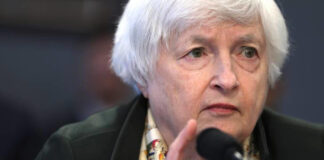APRIL 26, 2018

Ford Motor Co. is sharpening its knives to cleave another $11.5 billion from spending plans and cut several sedans, including the Fusion and Taurus, from its lineup to more quickly reach an elusive profit target.
The automaker expects to save $25.5 billion by 2022, Chief Financial Officer Bob Shanks told reporters Wednesday as Ford reported first-quarter earnings per share and revenue that beat estimates. The company now anticipates reaching an 8 percent profit margin by 2020, two years ahead of schedule.
The cuts are aimed at kick-starting a turnaround effort almost one year after Ford’s board ousted its chief executive officer. New CEO Jim Hackett has been trying to convince investors that betting on a rebound is a worthwhile wager by laying out plans to get rid of slow-selling, low-margin car models and refocusing the company around more lucrative sport utility vehicles and trucks.
“We’re going to feed the healthy part of our business and deal decisively with areas that destroy value,” Hackett said on an earnings call Wednesday. “We aren’t just exploring partnerships; we’ve now done them. We aren’t just talking about ideas; we’ve made decisions.”
Ford finds itself on a road similar to the route Fiat Chrysler Automobiles NV followed to pass Ford in North American profitability. Fiat Chrysler CEO Sergio Marchionne now wants to eclipse General Motors Co. before his retirement in 2019.
 Ford reported first quarter adjusted earnings of 43 cents a share, topping analysts’ average estimate of 41 cents. Automotive revenue rose to $39 billion, exceeding the average projection for $37.2 billion in a Bloomberg survey.
Ford reported first quarter adjusted earnings of 43 cents a share, topping analysts’ average estimate of 41 cents. Automotive revenue rose to $39 billion, exceeding the average projection for $37.2 billion in a Bloomberg survey.
Bottoming Out
Ford’s profit margin should “bottom out” this year, Hackett said on the call. The Asia Pacific region will probably lose money in the second quarter before returning to profit in the back half of the year. The company also is reviewing its strategic plans for South America.
“Everything will be on the table” to fix Ford, Shanks told reporters in Dearborn, Michigan, at the company’s headquarters. “We can make different investments, we can partner, we can exit products, markets — and we will do that.”
Ford shares rose as much 3.2 percent after the close of regular trading. Before the earnings report, the stock had dropped more than 11 percent this year.
“Sentiment is extremely low,” Adam Jonas, an analyst with Morgan Stanley who upgraded Ford to a buy rating in March, wrote in a report last week. “Our discussions with investors suggest low confidence in Ford’s earnings visibility and strategic vision. The product portfolio is seen as dated and overexposed to passenger car segments.”
One factor contributing to the pessimism has been commodity costs, which Ford expects will be a $1.5 billion headwind this year. About $500 million of that came in the first quarter, Shanks said. The automaker began the year flagging to investors that pricier raw materials including steel and aluminum would contribute to profit declining in 2018.
Killing Off Cars
Ford said it won’t invest in new generations of sedans for the North American market, eventually reducing its car lineup to the Mustang and an all-new Focus Active crossover coming next year. By 2020, almost 90 percent of its portfolio in the region will be pickups, SUVs and commercial vehicles.
Ford Fusion sedans
That means the end of the road for slow-selling sedans such as the Taurus, Fusion and Fiesta in the U.S. The automaker conspicuously left the Lincoln Continental and MKZ sedans off its hit list, but since those models share mechanical foundations with Ford siblings, their futures also are in doubt.
“For Ford, doubling down on trucks and SUVs could be just what the brand needs,” Jessica Caldwell, an analyst for Edmunds.com, said in an email. “But this move isn’t without risk: Ford is willingly alienating its car owners and conceding market share.”
Investors had been growing impatient for additional detail on the money-losing models Ford would ditch — and for signs its reorganization efforts would bear fruit.
“It’s not that the market has permanently given up on good news ever happening at Ford,” said David Whiston, an analyst with Morningstar Inc. who recently lowered his rating on the stock to the equivalent of a hold. “But most people aren’t expecting it until late 2019 or 2020 and that brings up the wild card of, ‘Will we be in a recession by then?’”
Hackett, 63, sought to assuage those concerns by promising “urgent” action.
“The hand-wringing that has been around in our business is gone,” he said. “We’re starting to understand what we need to do and are making clear decisions.”
(Updates with CEO’s comment in the fourth paragraph.)
Courtesy/Source: Bloomberg










































































































